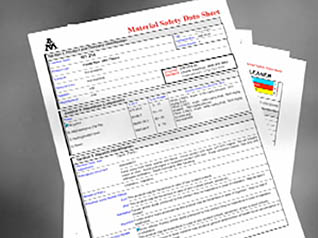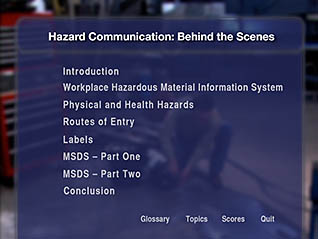Back to Course List
Hazcom: Hazard Communication: Behind The Scenes WHMIS
- Product ID
- aurohcbw
- Training Time ?
- 43 to 86 minutes
- Language(s)
- English
- Video Format
- Standard Definition
- Required Plugins
- MasteryNet Player
- Lesson Interactions
- 9
- Quiz Questions
- 30
- Closed Captioning



Overview
This training covers all aspects of working with hazardous materials. Following the Canadian WHMIS regulations (Workplace Hazardous Materials Information System), this course features high-quality, interactive video. Content addresses the roles and responsibilities from an employee and employer perspective, including the development and implementation of a WHMIS plan.
Other topics include physical and health hazards, chemical routes of entry into the body, information found on labels and MSDSs, and chemical safety in the home.
![]() This course is in the Advantage™ format, to read about Advantage™ features click here.
This course is in the Advantage™ format, to read about Advantage™ features click here.

- Rich multimedia presentation with interactions and quiz
- Print certificate and wallet card
- You have 30 days to complete the course
Workplaces
Audience
All Canadian workers.
Topics
The course presents the following topical areas:
-
Workplace Hazardous Materials Information System
- Employer responsibilities
-
Physical and Health Hazards
- Physical hazards
- Chemicals that produce physical hazards
- Health hazards
- Acute and chronic health effects
-
Routes of Entry
- Routes of entry explained
- Routes of entry examples
- Protection from airborne chemicals
- Protection from chemical absorption
- Avoiding contamination of food with your hands
-
Container Labels
- Finding labels
- Applying labels
- Information on container labels
- Transferring a chemical to another container
- Maintaining labels
-
Material Safety Data Sheets
- Product and company identification
- Exposure limits
- Emergency response
- Flash point
- Handling, Storage, PPE and exhaust ventilation
- Vapor Density
- Specific gravity
- Stability, reactivity, and poisonous effects
-
Household Chemicals
- Precautions with household chemicals
Intended Performance Outcomes
Upon successful completion of this course you will be better prepared to:
-
Explain the Right to Know Law employer requirements
- Recall the need to prepare a written plan.
- Explain the need to inventory hazardous chemicals.
- Recognize the need to maintain a Material Safety Data Sheet file.
- Identify the safety benefits of container labels.
- State the requirement to train employees about chemical safety procedures.
-
Protect yourself from the physical and health hazards of chemicals.
- Differentiate between physical and health hazards.
- Identify examples of physical hazards.
- List types of chemicals that produce physical hazards.
- Explain that chemicals can affect body systems as well as specific organs.
- Distinguish the difference between chronic and acute health effects.
-
Avoid chemicals entering your body.
- Define routes of entry.
- List a chemical's available routes of entry into the body.
- Choose the proper protection to avoid exposure from airborne chemica
- Select the proper procedure to avoid exposure from absorbtion through the skin and eyes.
- Identify the proper procedure used to avoid ingesting hazardous chemicals.
-
Read labels to locate necessary safety information.
- Agree that all containers of hazardous chemicals must be labeled.
- Name the person(s) responsible for labeling containers.
- List information found on container labels.
- Identify the labeling requirements when transferring a hazardous chemical from one container to another.
- Recognize the importance of label maintenance and legibility.
-
Use Material Safety Data Sheets to get specific information.
- List information contained in an MSDS.
- Define Permissible Exposure Limit.
- Define Threshold Limit Value.
- Identify the types of emergency information included in an MSDS.
- Define Flash Point.
© Mastery Technologies, Inc.


